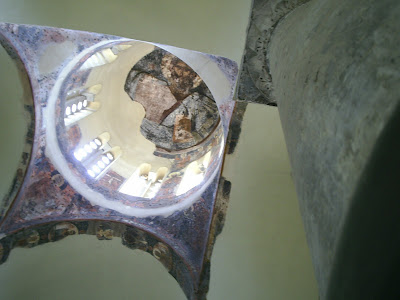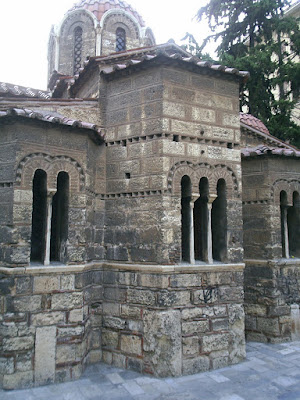Byzantine Roots - Athens
Unlike Thessalonika, Athens was not a great medieval city, and after the classical period existed as a small village until Greek independence in 1829, when, as the captial of the newly liberated country, it was enlarged and beautified. Accordingly, there is not a great number of Byzantine remains in Athens - mostly small churches, hemmed in by the modern city:



 A common theme in Greece and Constantinople is the late flowering of the arts under the last Imperial Byzantine dynasty, the Palaiologoi. In the churches of Athens, this is seen particularly in the decorative use of brickwork on the exteriors.
A common theme in Greece and Constantinople is the late flowering of the arts under the last Imperial Byzantine dynasty, the Palaiologoi. In the churches of Athens, this is seen particularly in the decorative use of brickwork on the exteriors.

 However, for a Byzantine enthusiast, there are two major museums to visit; the Benaki Museum, and the National Byzantine Museum, both exceedingly well presented, and filled with breathtaking treasures. A visitor cannot fail to realise how much we have lost of this great civilization, and what a dis-service has been rendered by those (beginning with Edward Gibbon) who have dismissed Byzantine culture as debased.
However, for a Byzantine enthusiast, there are two major museums to visit; the Benaki Museum, and the National Byzantine Museum, both exceedingly well presented, and filled with breathtaking treasures. A visitor cannot fail to realise how much we have lost of this great civilization, and what a dis-service has been rendered by those (beginning with Edward Gibbon) who have dismissed Byzantine culture as debased.
The range of artefacts provided a glorious insight into Byzantine culture. Not only painting, but everyday objects - below are beautifully preserved shoes from Byzantine Greece:
This capital shows an early example of the use of holes drilled into stone, to create the lace-like effect familiar in Byzantine architecture:
The illustrated manuscript below shows St John and St Mark:

St Barabara made an appearance, looking very different from the forms in which we recognise her in western art:
s
The ikon below a fine, late example of mosaic produced during the Palaiologan renaissance:
Below is St Demetrios, familiar from Thessalonika, another masterpiece produced on the eve of the Turkish conquest:
Lost in a Byzantine reverie, all I needed was for a figure from that era to appear. Lo and behold -
I cannot leave medieval Athens without homage to a hero: this is the statue of the last Byzantine Emperor, Constantine XI Palaiologos, in the Cathedral Square. I shall have cause to retun to this great, and tragic, figure in later postings!












2 comments:
The Byzantine museum is marvellous!
Excellent insight!
Post a Comment